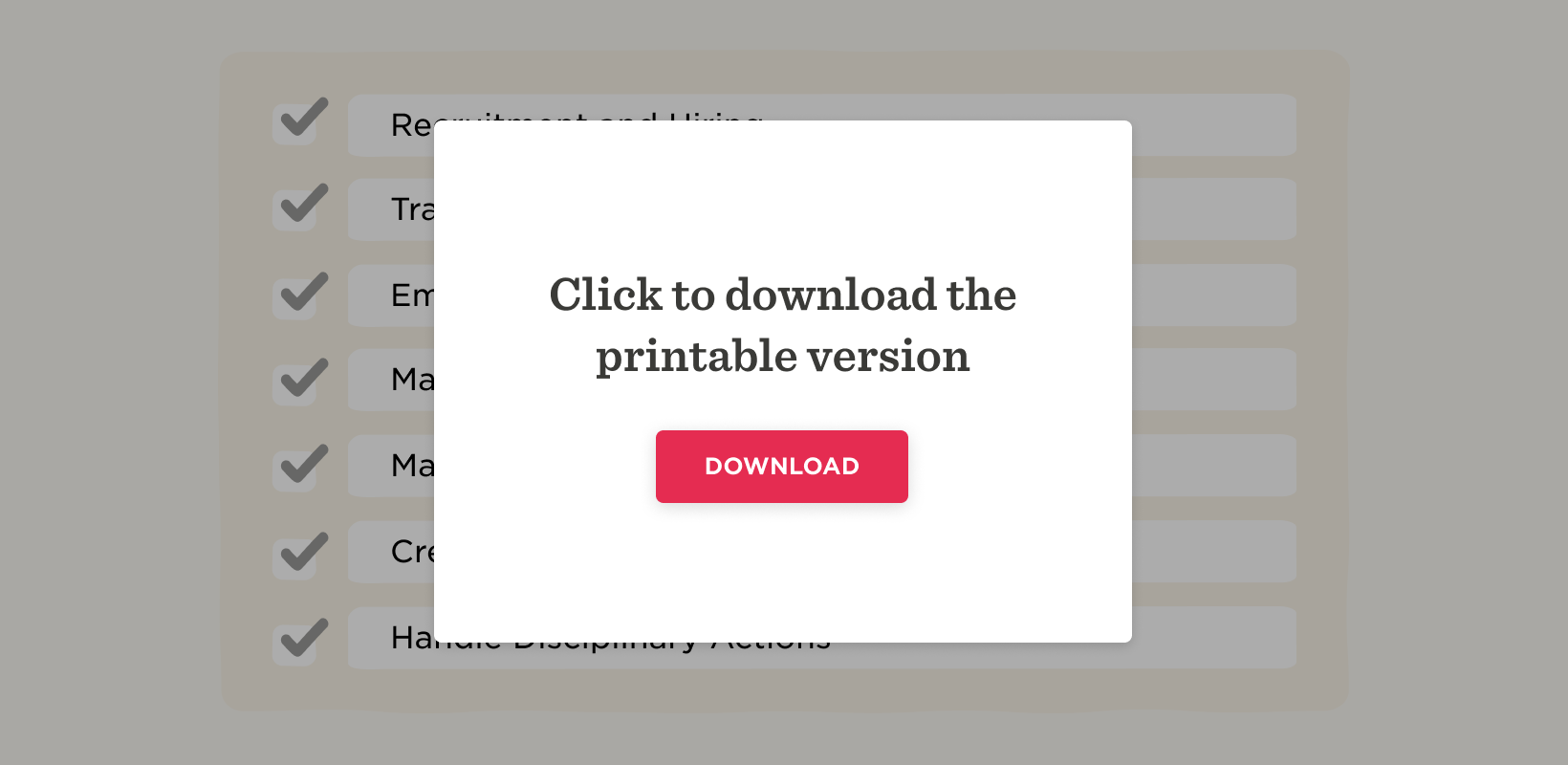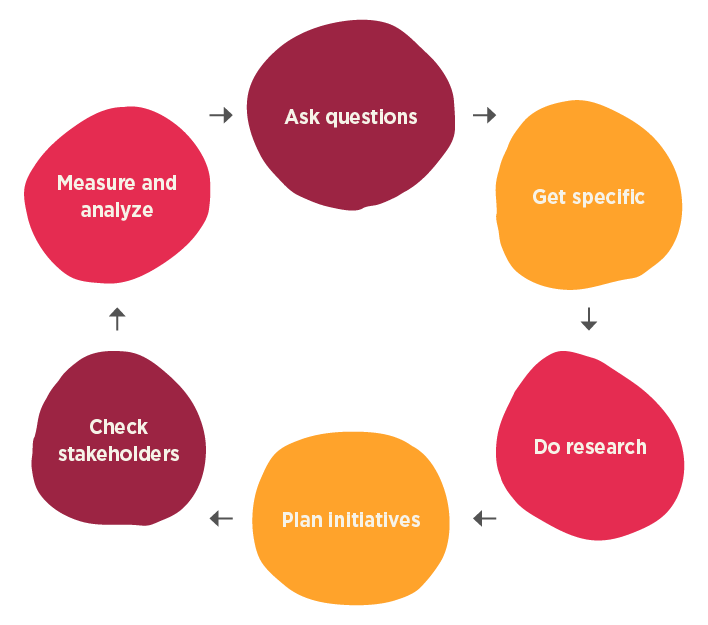What is an HR plan?
An HR plan provides a clear roadmap for HR professionals to deliver on their organization’s business goals. It encompasses the programs and plans around things like culture, tools, internal comms, hybrid/remote work, and benefits that the HR team owns. The introduction of an HR plan helps modern businesses prevent staffing shortages and surpluses—and ensures the best fit between employees and jobs.
HR plans consider your organization’s people today and forecast future work demands. With a clear HR plan, companies can remain productive and profitable. An HR plan supports the company’s business strategy for the coming year by ensuring a steady stream of skilled people is in place to keep everything on track.

Why is a strategic HR plan important?
Developing a strategic HR plan that connects your HR strategy with your broader business initiatives is invaluable. A strategic HR plan is a document that drives your business forward by evaluating where your workforce is at and comparing it to future needs. It sets out your organizational goals—and outlines how your HR team will help achieve them.
A strategic HR plan requires your company’s HR department to act as a strategic rather than an administrative business function. And it demands HR’s active involvement in wider discussions throughout your business. In short, strategic planning for HR demonstrates how the HR function can support broad organizational initiatives and help your company thrive.
Planning your HR activity in this way and being proactive rather than reactive enables HR professionals to solve significant business challenges—from costly employee turnover to productivity pitfalls. And it helps to achieve organizational goals with strategic recruitment, compensation, talent management, and succession planning.
How to plan your HR strategy
Want to get HR a seat at the table? You need to be strategic. Set aside time to plan out your biggest goals for the year. This way, you can hit the ground running with all the facts, figures, and strategies you need to succeed.
Here’s a checklist to help you structure your strategic HR plan. You’ll need to block out some time to do this effectively, so make sure you allow yourself a few focused hours.

1. Ask the relevant questions
This first step is when you’ll define your priorities for creating an effective strategy that helps you reach your goals. Build a thorough overview of the organization’s challenges, opportunities, and capability gaps to plan how to overcome them during the year.
Ask yourself:
- What capabilities in the business need to be strengthened?
- Will these capabilities be improved through development or by hiring new talent?
- How does culture impact your HR goals?
- What elements of your culture require bolstering?
- What tools, programs, comms, and strategies will be required to engage the organization at every level?
Gather as many facts and figures as you can, getting specific about teams, job roles, and territories
2. Do research
It’s also important to consider the world beyond your organization, including trends and factors to take into account when considering your strategic plan. This will involve some research via third-party organizations such as government, independent research bodies, and consultancies.
Look for:
- Any new legal requirements or regulations to consider
- Demographic trends in your territories
- Social and technological changes in the short- and mid-term
- Political movements within your business footprint
- Salary expectations for business-critical roles
- HR trends
3. Plan your initiatives
Based on your priorities and the micro and macro trends, it’s now time to start planning what strategies, projects, and initiatives you’ll put into place to achieve your goals for the year:
- What hiring strategies, development, pipelining, training, and compensation will be required to achieve your goals?
- What external and internal resources will be required to implement your strategies and projects?
- What is the anticipated budget requirement?
4. Check-in with your stakeholders
Often you’ll need buy-in from different parts of the organization to achieve your goals. This means you need to represent to the C-suite what your team’s contributions will be to achieving business goals.
5. Measure and analyze
HR strategies live and die by their data and analytics, so it’s important to rigorously plan out how you intend to capture, measure, and analyze the effectiveness of your strategies to report back to stakeholders.
It could be useful to compare this data to any external data you can find from other organizations, for example, via case studies. Measurement metrics can be collected through the following steps:
- Identifying and measuring KPIs
- Determining the different kinds of data that will need and compare it with? to be gathered, such as qualitative, quantitative, and self-reported from employees and team leaders.
- Establishing how your statistics will be measured. What software or platforms will you gather, measure,and compare it with?
What are the benefits of strategic human resources planning?
Strategic planning for HR syncs your HR strategy with your broader business initiatives.
As an HR professional, taking a strategic approach to planning offers many benefits, like improving levels of engagement within your organization, attracting superior talent, and reducing turnover.
Strategic analysis helps you determine if your people have everything they need to be productive—and identify the need for added resources to enhance productivity where necessary.
Assessing your existing talent and auditing compensation, benefits, work environments, and levels of engagement helps you enact better policies and retain valued talent. And introducing development plans can further support people’s professional growth within your business.
Best practices for implementing an HR strategy
While there isn’t a right or wrong way to build a successful HR strategy, you can follow certain best practices when developing and implementing yours.
- Align your HR strategy to your business needs by activating your people and processes to reach the goals and growth outlined in your business strategy
- Know your budget and focus on strategic initiatives that fit within your organization’s budget
- Identify what success looks like, establish key performance indicators, and track progress against them over the year
- Focus on collaboration and involve your key stakeholders and other business partners across your organization to get their support, buy-in, and sign-off
- Drive engagement through communication and use multiple channels to encourage everyone in your organization to support your HR strategy
- Measure your results in real-time and study what the data tells you to strengthen and reinforce your HR strategy with your stakeholders
- Monitor and adjust your HR strategy over time and revise it to achieve your desired results
Your strategic HR plan template
Practical and actionable—HR professionals can use this strategic HR plan template to ensure their business is well-staffed and well-served.
1. Look at your business—identify what you want to achieve
Start your strategic HR plan by establishing your current state, outlining what you’d like to achieve, and identifying the metrics to get you there. Focus on:
- Clarifying your overarching business strategy and goals
- Identifying the metrics related to your desired outcomes
2. Look at your people—and identify their skill sets
Next, consider your people and their collective performance, productivity, and skill sets. Your HR plan will support your company’s business strategy for the coming year by ensuring a steady stream of skilled people is ready to keep everything on track.
3. Do your people need anything?
A skills gap analysis will help you identify if your people could benefit from additional help, training, or resources to increase their productivity, knowledge, or abilities.
4. Where do you shine?
Assess your work environments and levels of engagement and audit the compensation and benefits you offer. Understanding your current state of where you stand can help you retain the people you value—and compete for new talent in the job market.
5. Grow your talent
Reviewing and understanding your current state allows HR professionals to look at their people, identify anyone ready to grow, and create a talent development plan.
6. Leaving so soon?
Your HR plan supports your company’s business strategy by ensuring a steady stream of skilled people is ready to keep everything on track. If you’re seeing a high talent turnover, now’s the time to investigate what’s happening and why— finding out what’s causing people to leave and addressing the root cause of their unhappiness.
7. Looking ahead
Succession planning can help HR professionals to reduce disruption. Identifying those people who could fill positions if they became vacant can smooth the way for people in the event of a sudden departure from the business.
8. Make data-driven decisions
Use data and analytics to guide your strategic decision-making. You can access a wealth of information by analyzing your compensation history, turnover rates, levels of engagement, and other HR metrics.
9. Where you’re going, why—and how
Developing mission and vision statements can help HR professionals stay on course as they implement a strategic HR plan. Refer to your mission and vision statements to check that you align with the broader business initiatives and connect with your strategic HR plan.

Documenting your strategic HR plan
HR strategy plans can be any length, but it’s helpful when thinking about writing an HR strategic plan to focus on clarity and simplicity so that HR leaders and the wider business can easily refer to the contents.
Try to be concise, relay the facts, and, where possible, use data visualizations to illustrate your point. By documenting your HR strategic plan, you also have a record of where you started and can course-correct where and when necessary as time passes.
Keep your mission and vision statements to hand as you deliver the organizational business goals outlined in your strategic HR plan. Referring to the statements often will ensure you align with the broader corporate strategy as you go.
What does a good HR strategy look like?
While a business strategy outlines how a business will achieve its goals and growth, a good HR strategy creates the internal structures needed to activate people and processes to reach those goals.
VaynerMedia
VaynerMedia is a mid-size marketing and advertising agency based in New York City, with additional offices in Los Angeles, London, Singapore, and Mexico City. The company’s strategy is all about people, putting human beings at the forefront of everything it does—ensuring its ideas and plans are culturally rich and consumer-led.
VaynerMedia approaches strategy with practicality, humility, and empathy and believes the most effective way to drive relevance and growth is by speaking specifically and differently to people based on who they are, by listening and understanding.
VaynerMedia is a perfect example of how an HR strategy can align seamlessly with a company’s broader business goals. Its people are not just its greatest asset—they’re a community. With an HRIS that manages the entire employee lifecycle, VaynerMedia puts its own people front and center and welcomes new hires into its positive culture and inclusive and friendly workplace.
Fiverr
Fiverr’s culture is built around its people-first perspective. The company’s mission is to change how the world works together, and it has fundamentally changed the way businesses and freelancers work with each other.
Fiverr prioritizes the individual members of its community and continuously strives to build an atmosphere of connection and inclusivity. The ‘people company’ loves its team members for who they are and celebrates their diverse backgrounds.
Fiverr’s HR strategy and mindset focus on the personal touch. With an HR team made up of 25 professionals, the company is dedicated to supporting its people. It sought a powerful HRIS to support its people throughout their entire employee lifecycle and provide a friendly and engaging way to communicate with its people worldwide.
Recommended For Further Reading
Save the Children Italia
For over 100 years, Save the Children has been improving the lives of children and provides emergency aid during times of natural disaster, war, and other conflicts. Save the Children Italia, the organization’s Italian branch, has sites in Rome and Milan and employs 219 permanent employees and 84 temporary workers with fixed-term contracts.
Following a period of growth in headcount and projects, Save the Children Italia decided to implement a modern HR platform to replace their spreadsheets and manual processes, modernize their performance management process, and create a sense of community for their people working remotely and in the field. They were passionate about moving from annual performance reviews to a continuous feedback model and replacing their top-down approach with 360-degree feedback for a more holistic and engaging experience.
Meet Bob
At HiBob, we’ve built a modern HR platform designed for modern business needs—today and beyond.
An HR platform such as Bob offers a one-stop shop for all things HR. It sits at the center of your HR ecosystem, is fully customizable, and grows with your organization.
For HR, it delivers automation of many common processes, allows greater oversight and visibility of the business, and centralizes all people data in a secure, user-friendly environment.
For managers, it provides access to data and insights to help them lead more effectively and streamline processes.
For employees, it’s the tools and information they need to connect, develop, and grow throughout their journey.
In a short time, Bob can be deployed to enable communication, collaboration, and connectivity that drives stronger engagement, productivity, and business outcomes.
